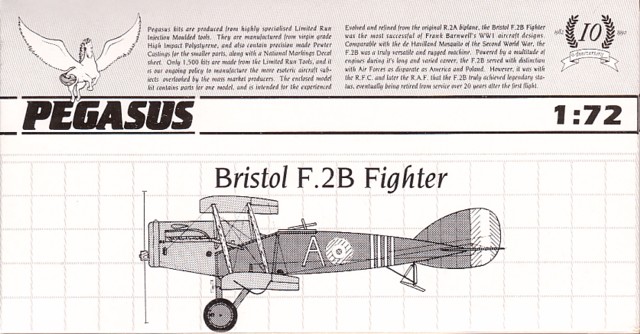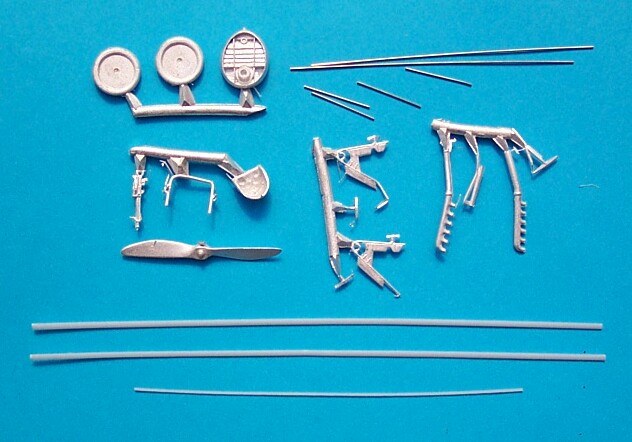|
Bristol F2B Fighter

Pegasus
S
u m m a r y
|
| Catalogue Number: |
Kit No. 4012 |
| Scale: |
1/72 |
| Contents and Media: |
18 parts in injection moulded
styrene; 14 parts in white metal; 6 steel rods; 3 lengths of airfoil
strut; markings for one aircraft |
| Price: |
USD$25.96 from Squadron.com
|
| Review Type: |
FirstLook |
| Advantages: |
Clean crisply moulded detail; thin
opaque decals; improved moulding technique. |
| Disadvantages: |
Tricky assembly due to subject
matter |
| Recommendation: |
Highly Recommended to the
experienced modeller. |
Reviewed by Robert Baumgartner

Pegasus's 1/72
scale Bristol F2B Fighter is available online from Squadron.com
An up to date kit of this famous two-seater has been long overdue but
finally the gap is filled.
The new Pegasus kit represents the later version of the F2B with the
single long intake above the exhaust manifolds, radiator shutters, and the
teardrop shaped blisters that covered the water pipe.
Contents
The contents contain the familiar selection of plastic, white metal and
steel rod as well as a decal sheet for one subject. As the kit points out,
this is for experienced modelers and extra reference material is
recommended. The instructions give an exploded view and the colours are
referenced to Xtracolor, Methuen, and Federal standards.
Pegasus kits just get better and better and this is immediately obvious
with the main components. The detail on the fuselage halves is the best
yet with all details being crisp. The representation of the stitching is
particularly well done, this being delicate and precise. As expected, the
outlines match Ian Stair’s plans in Volume 1 of the Datafile Special
precisely. Only the cleaning up of the air intakes is necessary. The
detailing of the fuselage walls is left to the modeller, but Pegasus does
provide the floor, seat and instrument panel. A quick going over with “wet
and dry” paper will smooth out the interior sidewalls.
The moldings of the wings show evidence that Chris Gannon is listening to
the consumer. Previous Pegasus kits have had their detail compromised by
having the sprue gates on the leading edge of the wing. The result was
loss of detail during the cleanup process and the necessary filling of the
moulding blemishes. This time, the sprue gates are actually on the wing
roots! Thus all the lovely rib detail is preserved and not a hint of
“ripple”. The wings also have very thin trailing edges and the ailerons
are moulded as separate items. Again, they are a perfect match to the
Datafile Special plans. Those with Ian Stair’s plans from the earlier
Datafile No.4 will notice a difference in such things as the aileron
length and under carriage shape. Thankfully Pegasus has used the later
plans as a guide for this kit.
Click the thumbnails below
to view larger images:
The white metal parts are very nicely done with little flash and good
detail. Items in this medium are the wheels, radiator, exhausts, tailskid,
seat, scarf mount, seat and rear Lewis gun. This latter item is quite
usable and requires only minimal cleanup. The white metal propeller and
undercarriage may raise an eyebrow though. Both are shorter than what is
represented on the plans but the final test will be a comparison between
the finished model and photographs.

Struts come in the form of extruded plastic and the instructions give the
correct lengths for cutting this material. The same applies to the
spreader bar and axle which come in the form of steel rod.
Decals are provided for D7966, a machine from 139 Squadron R.F.C. The
aircraft was only seven days old when it was brought down by Obit.
Friedrich Navratil of 3J on the 23rd August 1918. While flying Albatros
D.III (Oef) 253.06, he fired sufficient bullets into the engine to force
the crew to land where they were captured and made POWs.

Photos of this “Brisfit” before delivery and after capture show that it
was fitted with the extended exhaust pipes that continued diagonally down
to the bottom of the fuselage. The short versions of the exhausts that the
kit contains can be easily modified with some this tubing.
The decals have good colour density and were printed in perfect
register. Their thinness means that any carrier film will “disappear” and
decal-softening agents are not recommended or needed.
This is a most welcome release from Pegasus. Finally the Brisfit gets
the treatment it deserves. With their new molding technique and detail
that is sharper than ever, this is easily Pegasus’s best yet.
Highly Recommended.
Thanks to
Squadron.com for the review
sample.
Review and Images Copyright © 2002 by
Robert Baumgartner
Page Created 27 August, 2002
Last updated 22 July, 2003
Back to HyperScale Main Page
Back to Reviews Page
|
Home | What's
New | Features
| Gallery |
Reviews | Reference
| Forum
| Search